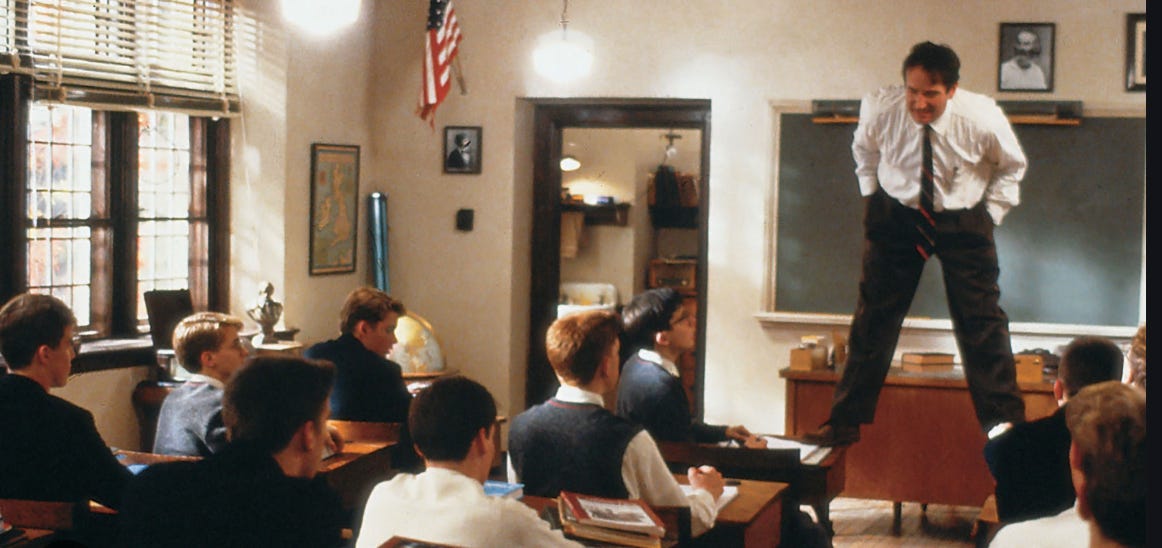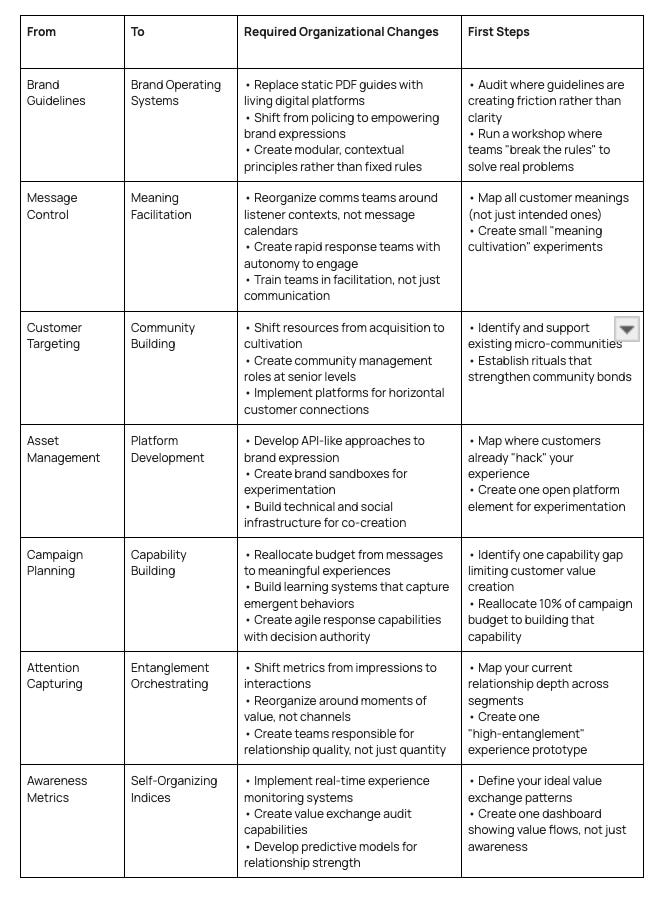The Demise of Single-State Brands Part 3
The Three Laws of Quantum Brands: How Leading Brands Are Rewriting The Rules of Customer Value Creation
Over recent weeks, we've traced the collapse of traditional brand models and explored how three-dimensional salience offers a way forward. Today, we're going deeper into the operating principles that govern the most innovative brands—the Three Laws of Quantum Brands.
But before we dive in, I want to share a personal story.
Fixed Assets In A Liquid World
About seven years ago, I was sitting in a quarterly business review meeting with a global CPG client. We were only halfway through our carefully crafted presentation when their CMO interrupted with a question that dogs me to this day: Why are we spending more every year in marketing while our pricing power and unit volume are both declining? She actually phrased it more pointedly than this.
An entire room of marketers looked anxiously at us. They’d supplied us with mountains of data about their brand equity, awareness scores, and consumer perception. The strength of these metrics suggested they had a strong business and a valuable brand. But when faced with this penetrating question about diminishing impact, none of their traditional measures offered a satisfying answer to what was going on.
I remember tossing and turning quite a lot that night. The CMO's question really highlighted a key contradiction in our approach to brand building. If we were being completely honest, we’d been guilty of managing the brand as if it were a solid asset. But in a rapidly changing world, this approach was akin to trying to shore up fortress walls on unstable ground.
The next morning, a bigger question came to mind: what if the way we'd been measuring customer value had fallen out of line with how they judged it?
This simple question set me off on a multi-year study journey. I studied rising and failing brands in a variety of industries and eventually noticed patterns in how strong brands approached customer value creation. These insights prompted me to develop the three laws of quantum branding outlined below.
Three Fundamental Laws of Creating Quantum Value
Three simple yet powerful laws govern how quantum brands operate—principles that cut across category, geography, and even business model.
1. The Law of Authentic Utility: Value Must Be Created, Not Just Communicated
I remember watching the pivotal scene in "The Social Network" where Jesse Eisenberg is furiously coding while his roommates sleep, building something out of pure creative energy. Way before anyone was concerned about positioning and a messaging playbook for Facebook, there was a raw authenticity to that moment—a direct connection between Zuck’s vision and that impulsive act of creation.
This is what the first law is all about: utility trumps hyperbole. In a quantum brandiverse, our brands need to create value, not merely promise it. I’d go as far as to say that our job as marketers shouldn’t be hyping our products but demonstrating how our brand makes people's lives better. In this way, customer value = inherent product value + augmented brand value.
Consider Notion, the productivity tool that's reached a $10 billion valuation with minimal traditional marketing. Their minimalist, customizable philosophy runs through everything they do—from product design to community building. When you use Notion, you're not just using a tool; you're adopting a philosophy about how information should be organized and shared.
The difference between Notion and their competitors isn't primarily in features or benefits—it's in how the entire Notion experience expresses the brand's total brand promise in every interaction. The product, community, and brand are inseparable because they never conceived of them as separate things in the first place.
Quantum Diagnostic: Authentic Utility
Is your brand creating value or just promising it? Ask yourself:
If you stripped away all marketing, would customers still choose you?
Does your product experience tell the same story as your advertising?
When customers interact with you, do they leave with more value than they arrived with?
Could your employees explain your brand's value without mentioning ads or slogans?
Are your highest-performing touchpoints the ones with the least marketing overlay?
Brands scoring "no" on three or more questions are likely operating in single-state mode—beautiful in theory but hollow in practice.
When Utility Isn't Authentic: Quibi's $1.75B Lesson
Quibi vaporized $1.75 billion by solving a problem nobody had. Their "quick bites" of premium content sounded revolutionary in boardroom presentations. But in users' actual lives? The utility wasn't there.
While Netflix created authentic utility by removing friction from entertainment consumption, Quibi added constraints that served their business model, not viewer needs. Quibi's content strategy, technology platform, and marketing all presented distinct narratives.
The result wasn't just failure—it was spectacular implosion. Without authentic utility as its foundation, no amount of celebrity partnerships, technical innovation, or marketing dollars could save Quibi from its fundamental disconnect.
2. The Law of Cultural Resonance: Brands Must Move at the Speed of Culture
There's a scene in the 2016 film "Moonlight" where the boys are playing in the ocean at twilight. The camera captures them in a dreamlike state, moving in perfect synchrony with the waves—not fighting against them, but becoming part of their natural rhythm. That's what cultural resonance feels like: rhythmic.
The second law recognizes that brands must move at the pace of culture, not your organization’s approval processes. This means creating systems for dialogue rather than control—shifting from messaging management to collaborating with customers.
The online gaming brand Roblox exemplifies this principle. It doesn't just participate in culture—it provides the infrastructure for cultural creation, blurring boundaries between platform, creator, and user in a continuous flow of co-created experiences.
When Gucci launched their virtual garden on Roblox, something remarkable happened. The digital Gucci bags weren't just products—they became cultural artifacts that gained extraordinary value within the platform's ecosystem. One digital Gucci Dionysus bag sold for over 4,000 Robux (approximately $4,115), far exceeding the price of the bag in Gucci's virtual space. The digital items weren't just representations of luxury; they were native to the cultural context in which they existed, demonstrating how value can manifest differently across physical and digital realms.
Contrast this with brands still operating on a campaign calendar designed around quarterly targets rather than cultural rhythms, marketing plans that assume culture will conform to their timeline, not recognizing that culture flows like water—finding the path of least resistance and carving new channels when blocked.
Quantum Diagnostic: Cultural Resonance
Is your brand adapting to the changing culture, or is it trapped in quarterly planning cycles? Test yourself:
Have you created anything in the past year that wasn't on your original marketing calendar?
Can your brand respond meaningfully to cultural events within 24 hours?
Do customers use your products/services in ways you never intended or planned?
Does your culture budget allocate resources for opportunities you can't yet name?
Are you studying cultural shifts that seem irrelevant to your category but matter to your customers?
If you said "no" to most of the questions, it means that your brands are probably stuck in cultural limbo while your market moves forward.
Cultural Tone-Deafness: Pepsi's Protest Misstep
Pepsi's 2017 protest commercial featuring Kendall Jenner missed the cultural moment but also swiftly embraced it. While genuine social movements were confronting serious issues, Pepsi's attempt to insert its product as a solution to social tension felt a bit tone-deaf.
The campaign wasn't created at the speed of culture; it was created at the speed of corporate approval processes. The result looked like marketing created in a hermetically sealed boardroom, completely disconnected from the actual cultural conversations happening outside.
What's most telling: Pepsi had months to create this campaign, while competitors like Ben & Jerry's could authentically respond to cultural moments in hours. When brands move slower than culture, they don't just miss the moment—they risk becoming case studies in what not to do.
3. The Law of Co-Creating Value: A Brand's True Value Comes From Enabling Creation by Others
Most of you will likely be too young to remember the iconic scene from "Dead Poets Society" in which Robin Williams stands on his desk to change his students' perspective. "I stand upon my desk to remind myself that we must constantly look at things in a different way," he says.
The third law requires exactly this kind of perspective shift: A brand's value doesn't come from controlling the message; it comes from enabling value creation by others.
Oatly doesn't just sell alt. milk; it creates a "reality field" where choosing its product embodies a specific worldview about sustainability, food systems, and personal health. Its packaging, marketing, sustainability initiatives, and even its corporate structure create a unified system that customers engage with as co-creators rather than passive consumers.
When you buy Oatly, you're not just buying a milky beverage; you're joining a mission-driven movement. The value isn't just in its oaty goodness —it's in the meaning-making system that surrounds it, a system customers actively participate in rather than merely observe.
Quantum Diagnostic: Co-Creation Capacity
Is your brand enabling others to create value or hoarding control?
Do customers actively modify or extend your products/services in ways you support?
Are user innovations formally incorporated into your development process?
Does your community create more content about your brand than you do?
Can you name three ways customers have improved your offering that you didn't anticipate?
Would your legal team describe your brand assets as "protected" or "shared"?
Brands still clutching control are operating with industrial-era DNA in a networked world.
Co-Creation Collapse: MoviePass's One-Way Value Proposition
MoviePass built a service where only customers could create value—and only by extracting it from the company. Their unlimited movie ticket model created tremendous user value but failed to establish reciprocal value flows between users, theaters, studios, and the platform.
Instead of creating a network where value flowed in multiple directions, they built a one-way value extraction machine. Without designing for co-creation, MoviePass had no way to transform customer enthusiasm into sustainable value.
The most telling signal? When MoviePass needed to evolve their business model to survive, its community turned against them rather than collaborating on solutions. They'd built a transactional relationship, not an ecosystem of value—and the company ultimately lost everything because of it.
From Rigid Structures to Adaptive Intelligence: Entangled Brand Value
When these three laws combine, they create a value that surpasses their individual components, a concept I call "entangled brand value." In this state, the boundaries between brand, customer, and culture are permeable, allowing value to flow in multiple directions rather than being projected from brand to consumer.
Think again about the difference between a house and a home we talked about in Part 2. A house is a structure that can be designed, built, valued, and traded as a commodity. A home, on the other hand, is a constantly changing, emotionally charged space shaped by the people who live there. Its value can’t be reduced to square footage or location because its meaning is constantly co-created by its residents.
Traditional brands are houses—fixed assets designed for stable markets. Quantum brands are homes—adaptive systems that gain value through collaborative meaning-making and evolve alongside their communities.
How Lego Transformed Itself Through These Laws
I happen to think that Lego is a wonderful example of a brand that almost failed before reinventing itself using these three laws (even if they didn’t have this specific language at the time).
By 2003, Lego was on the brink of bankruptcy. They’d drifted from their core purpose, expanded too rapidly into unrelated categories, and lost touch with their core community. Their response wasn't just a strategic pivot—it was a fundamental reconceptualization of what the Lego brand could be.
First, they recommitted to authentic utility—focusing relentlessly on the core building system that had always been their strength. Rather than chasing trends, they deepened what made them unique.
Second, they embraced cultural resonance—shifting from a product company to a platform for creativity. The Lego Ideas platform invited fans to design sets that could become official products, while Lego Masters celebrated building as a cultural practice rather than just a children's activity.
Finally, they mastered co-creation—recognizing that their most passionate fans were already creating value independently. Rather than trying to control this energy, they amplified it, creating ecosystems where AFOLs (Adult Fans of Lego) could thrive.
The result wasn't just an admirable financial recovery; it was a transformation into something more valuable and resilient. Today, Lego doesn't just make toys; it also creates systems for imagination, play, and personal expression that transcend age, geography, and cultural contexts.
What This Means for Brand Leaders
For CMOs and marketing leaders, these three laws require fundamentally rethinking how our industry builds brands for the chaos of the experience economy.
Beyond Awareness: Quantum Brand Metrics
Traditional brand metrics are like trying to understand an ecosystem by counting trees. You'll get a number but miss the living system. Quantum brands require new measurement approaches that capture the dynamic, co-created nature of brand value.
Autopoietic Indices: These are measurements of a brand's self-creating, self-sustaining capabilities—its ability to generate new value without additional investment. Unlike traditional metrics that measure what you put in, these measure what the system creates on its own.
Five metrics worth implementing immediately:
Value Velocity: How quickly does customer value compound through your ecosystem? Measure the time between the initial purchase and subsequent value creation events.
Adaptation Rate: How effectively does your brand respond to emerging customer needs? Track the gap between identifying opportunities and implementing solutions.
Community Multiplier: How much value do customers create for each other? Measure peer-to-peer interactions, contributions, and value exchanges.
Cultural Currency: How often is your brand meaningfully incorporated into cultural conversations? Track authentic mentions, adaptations, and cultural references.
Experience Coherence: How consistently does your actual customer experience deliver on your brand promise? Measure the gap between promised and delivered value across touchpoints.
These metrics don't just measure what your brand is—they measure what it's becoming. They track your transformation from static entity to living system.
Your Quantum Readiness Audit
Ready to assess your brand's quantum capabilities? This quick audit reveals how prepared you are to thrive in the experience economy. Rate your organization from 1 (entirely traditional) to 5 (fully quantum) on each dimension:
Value Creation Model
(1) Value is designed by us, delivered to customers
(3) Value is designed by us, configured by customers
(5) Value emerges through interactions we enable but don't control
Cultural Stance
(1) We observe culture and align our messaging accordingly
(3) We actively participate in cultural conversations
(5) We provide infrastructure for cultural creation
Organizational Structure
(1) Brand stewardship lives in marketing/communications
(3) Brand experience is managed across departments
(5) Our organization is structured around customer value journeys
Decision Velocity
(1) Brand decisions require extensive review processes
(3) Some teams can make real-time brand decisions
(5) Our brand systematically evolves through distributed decision-making
Metrics Orientation
(1) We measure brand perception and performance
(3) We measure brand interactions and relationships
(5) We measure value flows and ecosystem health
Experimentation Approach
(1) We test marketing executions before launch
(3) We run limited brand experience experiments
(5) We continuously evolve through parallel experimentation
Total Score Interpretation:
6-12: Classical Brand (High vulnerability to disruption)
13-20: Transitional Brand (Building quantum capabilities)
21-30: Quantum Brand (Leading the experience economy)
A low score shouldn't deter you—every quantum brand began somewhere. The key isn't where you are, but whether you're ready to evolve. The first step is acknowledging that yesterday's brand operating system cannot support tomorrow's brand challenges.
Tomorrow, pick just one dimension where a single-point improvement would create the most value for your customers. Then run a 30-day quantum experiment in that space. Small changes in initial conditions can lead to dramatic evolution over time.
Next Time
In our final installment, we'll turn theory into practice with a strategic framework for CMOs and brand leaders ready to evolve their brands from static entities to quantum systems. We'll explore the specific capabilities, metrics, and organizational structures required to operate in this new landscape—and the first steps any brand can take to begin this transformation.
The quantum brandverse isn't coming—it's already here. The only question is whether your brand will evolve to thrive within it or remain trapped in an obsolete operating system while the world moves on.









Finally someone has put together a simple straight forward multidimensional look at brand value, how it's created, use of utility proposition and pointing out the value of customers, who are individual people, creating their own stories of brand value. Sounds like someone was sitting in a room overloaded with defensive marketing data. I witnessed the 2017 Pepsi commercial tone deaf debacle first hand, it was ugly, offensive and those who made it left the business promptly.
Adrian thanks for articulating this so clearly. Do you have a view on this approach and its relevance for digital brands/products vs non digital? The age of utility has been the new age driven by digital brands.